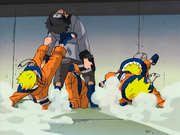(What Omni said.) Tag: sourceedit |
Kunoichi101 (talk | contribs) mNo edit summary |
||
| (6 intermediate revisions by 3 users not shown) | |||
| Line 5: | Line 5: | ||
|unnamed jutsu=No |
|unnamed jutsu=No |
||
|romaji=Uzumaki Naruto Rendan |
|romaji=Uzumaki Naruto Rendan |
||
| − | |literal english=Naruto Uzumaki Combo |
||
|english tv=Naruto Uzumaki Barrage |
|english tv=Naruto Uzumaki Barrage |
||
|other names={{translation|Boruto Uzumaki Combo|うずまきボルト連弾|Uzumaki Boruto Rendan}} |
|other names={{translation|Boruto Uzumaki Combo|うずまきボルト連弾|Uzumaki Boruto Rendan}} |
||
| Line 21: | Line 20: | ||
|jutsu media=Anime, Manga, Game |
|jutsu media=Anime, Manga, Game |
||
}} |
}} |
||
| − | Using the Shadow Clone Technique, Naruto divides himself in five. |
+ | Using the Shadow Clone Technique, Naruto divides himself in five. One clone punches the target in the face, as they yell "U-ZU-MA-KI", the three of the other clones kick the enemy into the air. Then, while the enemy is launched in mid-air, the original body assaults it with a somersaulting heel drop while yelling "Naruto Rendan!", sometimes using the posture of the first body for leverage to achieve the airtime. |
| + | |||
| + | The name of the technique is directly lifted off [[Sasuke Uchiha]]'s Lion Combo, which was based off of [[Lee]]'s taijutsu. However, it can be said to be a Naruto-original [[ninjutsu]]. |
||
== Trivia == |
== Trivia == |
||
* While this technique is the same as the Lion Combo, it is given a higher rank because of Naruto's use of shadow clones. |
* While this technique is the same as the Lion Combo, it is given a higher rank because of Naruto's use of shadow clones. |
||
| − | * In |
+ | * In Part II, Naruto appears to stop using this technique and is not seen performing it until his final fight with Sasuke. |
| − | * In Part II, Naruto appears to stop using this technique and is not seen performing it until his final fight with Sasuke, although he still frequently uses shadow clones. In the [[Drive Towards Darkness|''Naruto: Shippūden'' episode 196]], Naruto impersonated Sasuke and briefly referred to the technique as Lion Combo. Although technically it is a Part II episode, it is an anime-exclusive episode and also a flashback episode of Part I. |
||
* In the anime, Naruto seems to perform this technique in different ways depending on the situation. The only part that doesn't change is the final kick while the target is airborne. |
* In the anime, Naruto seems to perform this technique in different ways depending on the situation. The only part that doesn't change is the final kick while the target is airborne. |
||
Revision as of 00:16, 1 May 2016
Using the Shadow Clone Technique, Naruto divides himself in five. One clone punches the target in the face, as they yell "U-ZU-MA-KI", the three of the other clones kick the enemy into the air. Then, while the enemy is launched in mid-air, the original body assaults it with a somersaulting heel drop while yelling "Naruto Rendan!", sometimes using the posture of the first body for leverage to achieve the airtime.
The name of the technique is directly lifted off Sasuke Uchiha's Lion Combo, which was based off of Lee's taijutsu. However, it can be said to be a Naruto-original ninjutsu.
Trivia
- While this technique is the same as the Lion Combo, it is given a higher rank because of Naruto's use of shadow clones.
- In Part II, Naruto appears to stop using this technique and is not seen performing it until his final fight with Sasuke.
- In the anime, Naruto seems to perform this technique in different ways depending on the situation. The only part that doesn't change is the final kick while the target is airborne.
References
- ↑ First Databook, page 163

